Effects on NPK Status, Growth, Dry Matter and Yield of Rice (Oryza sativa) by Organic Fertilizers Applied in Field Condition
Abstract
1. Introduction
2. Materials and Methods
2.1. Description of Experimental Site
2.2. Experimental Design and Treatment Application
2.3. Application of Organic Fertilizers and CFs
2.4. Sampling and Soil Analyses
2.5. Analyses of Organic Fertilizers
2.6. Crop Management
2.7. Measurement of Plant Growth Characteristics
2.8. Determination of Dry Matter Production, Nutrient Content, Yield, and Yield Characteristics
2.9. Statistical Analyses
3. Results
3.1. Plant Growth Characteristics
3.2. N, P, and K Contents in Plant Parts at Critical Growth Stages
3.3. N, P, and K Accumulation in Rice Plants at Harvest
3.4. HI, Yield, and Yield Characteristics
4. Discussion
5. Conclusions
Author Contributions
Funding
Acknowledgments
Conflicts of Interest
References
- FAO. Rice Market Monitor; Food and Agriculture Organization (FAO) of the United Nations: Rome, Italy, 2018. [Google Scholar]
- Haider, I.K. Appraisal of biofertilizers in rice: To supplement inorganic chemical fertilizer. Rice Sci. 2018, 25, 357–362. [Google Scholar]
- Stellacci, A.M.; Cristiano, G.; Rubino, P.; Lucia, B.D.; Cazzato, E. Nitrogen uptake, nitrogen partitioning and N-use efficiency of container- Grown Holmoak (Quercus ilex L.) under different nitrogen levels and fertilizer sources. J. Food Agric. Environ. 2013, 11, 132–137. [Google Scholar]
- Mantovani, J.R.; Silveira, L.G.D.; Landgraf, P.R.C.; Santos, A.R.D.; Costa, B.D.S. Phosphorus rates and use of cattle manure in potted gerbera cultivation. Ornam. Hortic. 2017, 23, 412–418. [Google Scholar] [CrossRef][Green Version]
- Chen, J.H. The combined use of chemical and organic fertilizers and/or biofertilizer for crop growth and soilfertility. In Proceedings of the International Workshop on Sustained Management of the Soil-RhizosphereSystem for Efficient Crop Production and Fertilizer Use, Bangkok, Thailand, 16–20 October 2006; Volume 16, p. 20. [Google Scholar]
- Zhong, W.; Cai, Z. Long-term effects of inorganic fertilizers on microbial biomass and community functional diversity in a paddy soil derived from quaternary red clay. Appl. Soil Ecol. 2007, 36, 84–91. [Google Scholar] [CrossRef]
- Ladha, J.K.; Dawe, D.; Pathak, H.; Padre, A.T.; Yadav, R.L.; Singh, B.; Singh, Y.; Singh, Y.; Singh, P.; Kundu, A.L.; et al. How extensive are yield declines in long-term rice-wheat experiments in Asia? Field Crops Res. 2003, 81, 159–180. [Google Scholar] [CrossRef]
- Bijay-Singh; Singh, V.K. Fertilizer management in rice. In Rice Production Worldwide; Chauhan, B.S., Jabran, K., Mahajan, G., Eds.; Springer International Publishing AG: Dordrecht, The Netherlands, 2017; pp. 217–253. [Google Scholar]
- Myint, A.K.; Yamakawa, T.; Zenmyo, T.; Thao, H.T.B.; Sarr, P.S. Effects of organic-manure application on growth, grain yield, and nitrogen, phosphorus, and potassium recoveries of rice variety Manawthuka in paddy soils of differing fertility. Commun. Soil Sci. Plant. Anal. 2011, 42, 457–474. [Google Scholar] [CrossRef]
- Timsina, J.; Connor, D.J. Productivity and management of rice–wheat cropping systems: Issues and challenges. Field Crop. Res. 2001, 69, 93–132. [Google Scholar] [CrossRef]
- Gruhn, P.; Goletti, F.; Yudelman, M. Integrated nutrient management, soil fertility, and sustainable agriculture: Current issues and future challenges; Food, Agriculture, and the Environment Discussion Paper 32; International Food Policy Research Institute: Washington, DC, USA, 2000. [Google Scholar]
- Rezaenejad, Y.; Afyuni, M. Effect of organic matter on soil chemical properties and corn yield and element uptake. J. Sci. Tech. Agric. Natur. Res. 2001, 4, 19–29. [Google Scholar]
- Nishio, M. Basic Knowledge of Using Compost and Organic Fertilizers; Association of Rural and Fishing Cooperation: Tokyo, Japan, 2007; p. 213. (In Japanese) [Google Scholar]
- Liu, M.; Hu, F.; Chen, X.; Huang, Q.; Jiao, J.; Zhang, B.; Li, H. Organic amendments with reduced chemical fertilizer promote soil microbial development and nutrient availability in a subtropical paddy field: The influence of quantity, type and application time of organic amendments. Appl. Soil Ecol. 2009, 42, 166–175. [Google Scholar] [CrossRef]
- Dissanayake, S.T. Increasing rice yields through integrated plant nutrition systems to face the new millennium. In Proceedings of the International Conference on Paddy Soil Fertility, Manila, Philippines, 24–27 April 2000. [Google Scholar]
- Khan, M.U.; Qasim, M.; Khan, I.U. Effect of integrated nutrient management on crop yields in rice-wheat cropping system. Sarhad. J. Agric. 2007, 23, 1019–1026. [Google Scholar]
- Kumar, P.; Singh, F.; Singh, A.P.; Singh, M. Integrated nutrient management in rice-pea cropping system for sustainable productivity. Int. J. Eng. Res. Tech. 2014, 3, 1093–1095. [Google Scholar]
- Ohyama, T.; Ito, M.; Kobayashi, K.; Araki, S.; Yasuyoshi, S.; Sasaki, O.; Yamazaki, T.; Soyama, K.; Tanemura, R.; Mizuno, Y.; et al. Analytical procedures of N, P, K contents in plant and manure materials using H2SO4-H2O2 Kjeldahl digestion method. Bull. Facult. Agric. Niigata University 1991, 43, 110–120, (In Japanese with English summary). [Google Scholar]
- Cataldo, D.A.; Schrader, L.E.; Youngs, V.L. Analysis by digestion and colorimetric assay of total nitrogen in plant tissues high in nitrate. Crop. Sci. 1974, 14, 854–856. [Google Scholar] [CrossRef]
- Murphy, J.; Riley, J. A modified single solution method for the determination of phosphate in natural waters. Anal. Chim. Acta. 1962, 27, 31–36. [Google Scholar] [CrossRef]
- Muramoto, J.; Goto, I.; Ninaki, M. Rapid analysis of exchangeable cations and cation exchange capacity (CEC) of soils by shaking extraction method. J. Soil Sci. Plant. Nutr. 1992, 63, 210–215, (In Japanese with English summary). [Google Scholar]
- Sahrawat, K.L. Nitrogen availability indexes for submerged rice soils. Adv. Agron. 1983, 36, 415–451. [Google Scholar]
- Truog, E. The determination of the readily available phosphorus in soils. J. Am. Soc. Agron. 1930, 22, 874–882. [Google Scholar] [CrossRef]
- Curtin, D.; Wright, C.E.; Beare, M.H.; Mccallum, F.M. Hot water-extractable nitrogen as an indicator of soil nitrogen availability. Soil Sci. Soc. Am. J. 2006, 70, 1512–1521. [Google Scholar] [CrossRef]
- Yoshida, S. Fundamental of Rice Crop. Science, 1st ed.; International Rice Research Institute: Los Baños, Laguna, Philippines, 1981; p. 269. [Google Scholar]
- Sarker, U.K.; Uddin, M.R.; Sarkar, M.A.R.; Salam, M.A.; Khairul, A. Influence of organic and inorganic nitrogen on the growth and yield of irrigated rice. Asian-Aus. J. Biosci. Biotech. 2017, 2, 9–23. [Google Scholar]
- Maiti, R.K.; Rakshit, A.; Sarkar, N.C. Plant nutrition and management. In Advances in Rice Science; Maiti, R.K., Sarkar, N.C., Eds.; New Delhi Publishers: New Delhi, India, 2010; p. 574. [Google Scholar]
- Liu, Y.; Ding, Y.F.; Wang, Q.S.; Meng, D.X.; Wang, S.H. Effects of nitrogen and 6-benzylaminopurine on rice tiller bud growth and changes in endogenous hormones and nitrogen. Crop. Sci. 2011, 51, 786–792. [Google Scholar] [CrossRef]
- Bassi, D.; Menossi, M.; Mattiello, L. N supply influences photosynthesis establishment along the sugarcane leaf. Sci. Rep. 2018, 8, 2327. [Google Scholar] [CrossRef] [PubMed]
- Enujeke, E.C. Effects of poultry manure on growth and yield of improved maize in Asaba area of delta state, Nigeria. J. Agric. Vet. Sci. 2013, 4, 4–30. [Google Scholar]
- Amanullah; Hidayatullah. Influence of organic and inorganic nitrogen on grain yield and yield components of hybrid rice in Northwestern Pakistan. Rice Sci. 2016, 23, 326–333. [Google Scholar] [CrossRef]
- Gewaily, E.E.; Ghoneim, A.M.; Osman, M.M.A. Effects of nitrogen levels on growth, yield and nitrogen use efficiency of some newly released Egyptian rice genotypes. Open Agric. 2018, 3, 310–318. [Google Scholar]
- Hamadtou, G.A.F. Effect of Organic, Inorganic fertilizer and biofertilizer on growth, yield and quality of rice (Oryza sativa L.) under Sudan conditions. Ph.D. Thesis, Sudan University of Science and Technology, Khartoum, Sudan, 2016; p. 100. [Google Scholar]
- Rajni, R.; Srivastava, O.P.; Rani, R. Effect of integration of organics with fertilizer N on rice and N uptake. Fert. News 2001, 46, 63–65. [Google Scholar]
- Devivedi, D.K.; Thakur, S.S. Effect of organic and inorganic fertilizers levels on productivity of rice (Oryza sativa) crop. Ind. J. Agron. 2000, 45, 568–574. [Google Scholar]
- Miller, H.B. Poultry litter induces tillering in rice. J. Sustain. Agr. 2007, 31, 1–12. [Google Scholar]
- Kusalkar, D.V.; Awari, V.R.; Pawar, V.Y.; Shinde, M.S. Physiological parameters in relation to grain yield in rabi sorghum on medium soil. Adv. Plant. Sci. 2003, 16, 119–122. [Google Scholar]
- Nishida, M.; Sumida, H.; Kato, N. Fate of nitrogen derived from 15N-labeled cattle manure compost applied to a paddy field in the cool climate region of Japan. Soil Sci. Plant. Nutr. 2008, 54, 459–466. [Google Scholar] [CrossRef]
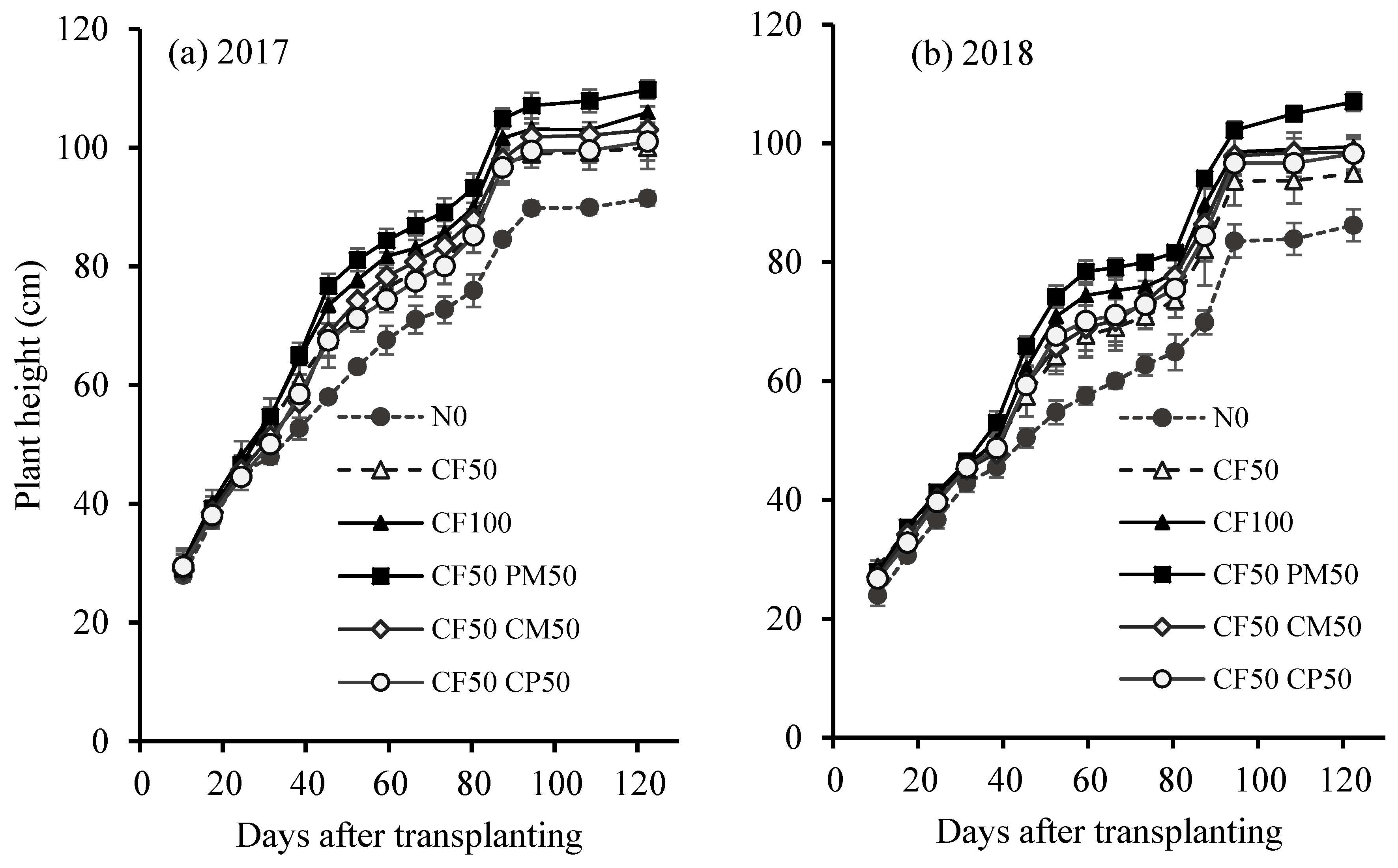
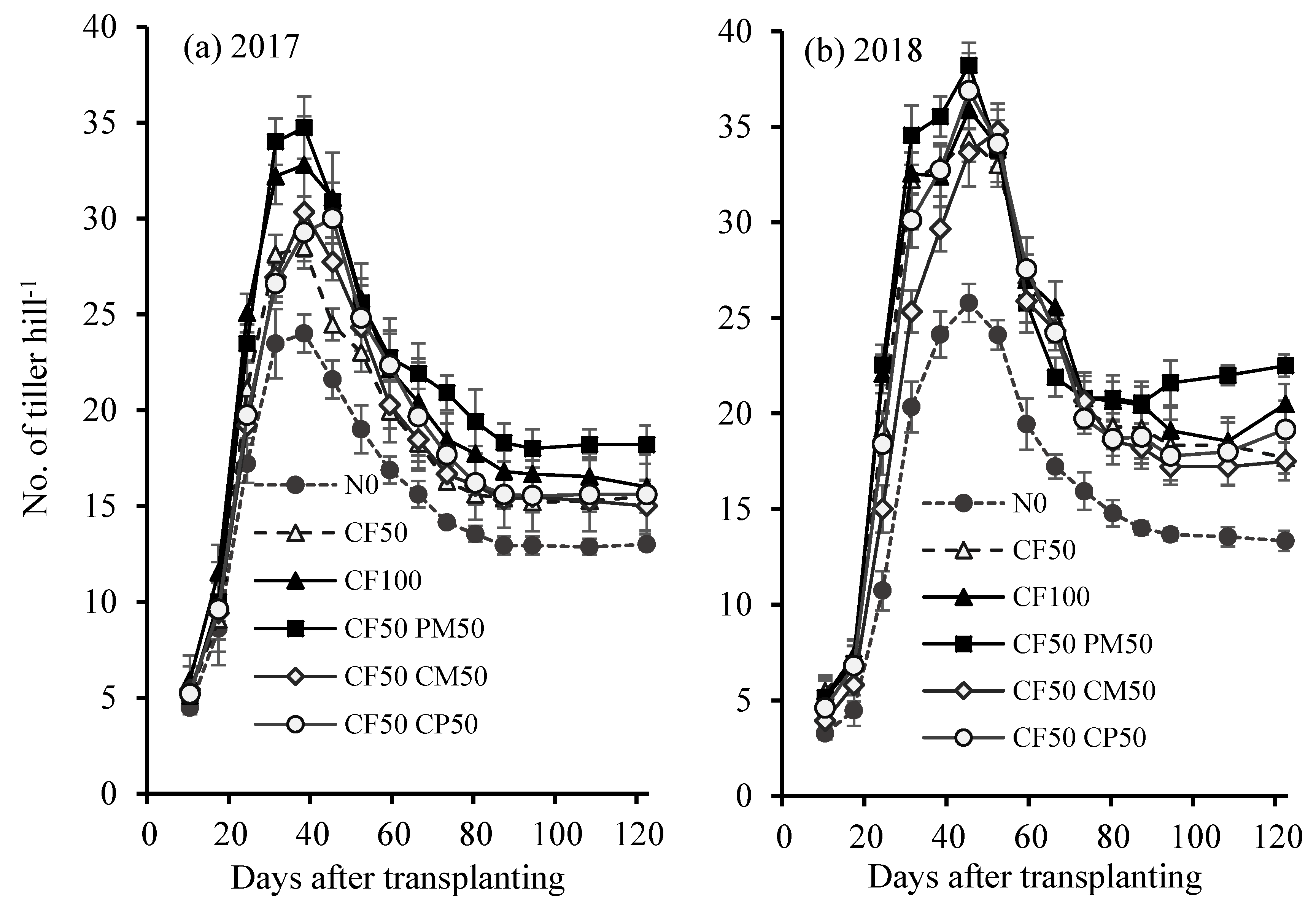
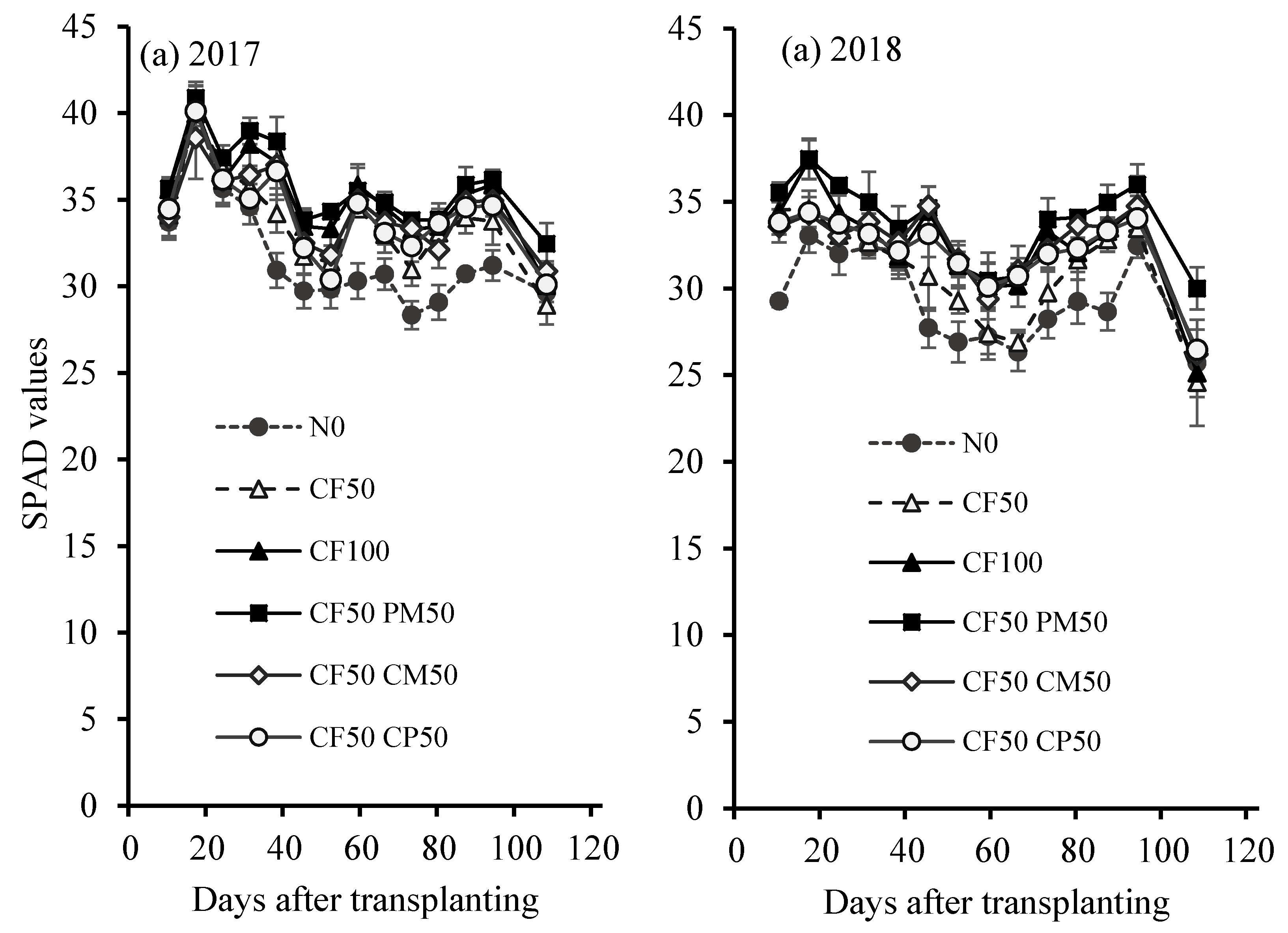
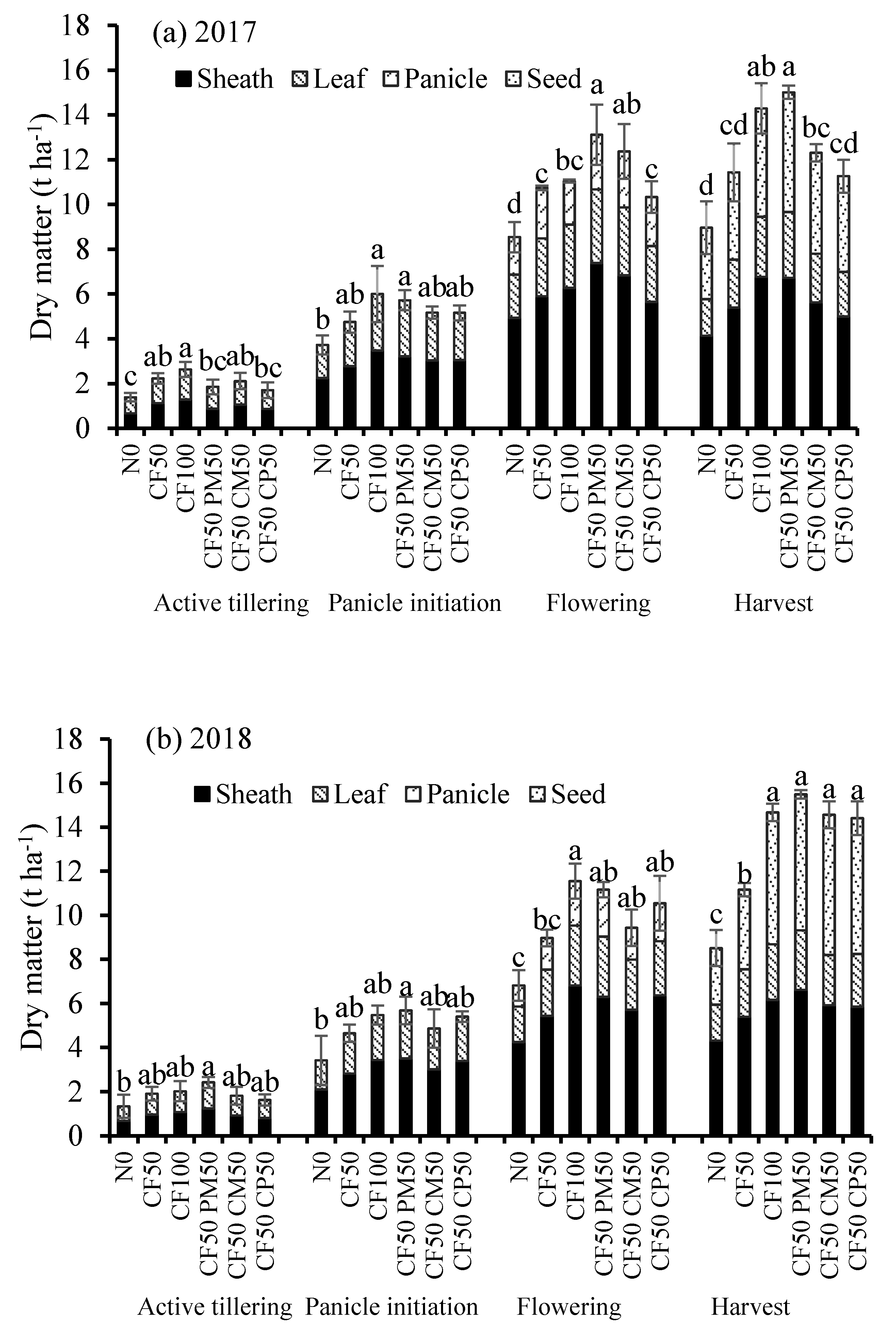
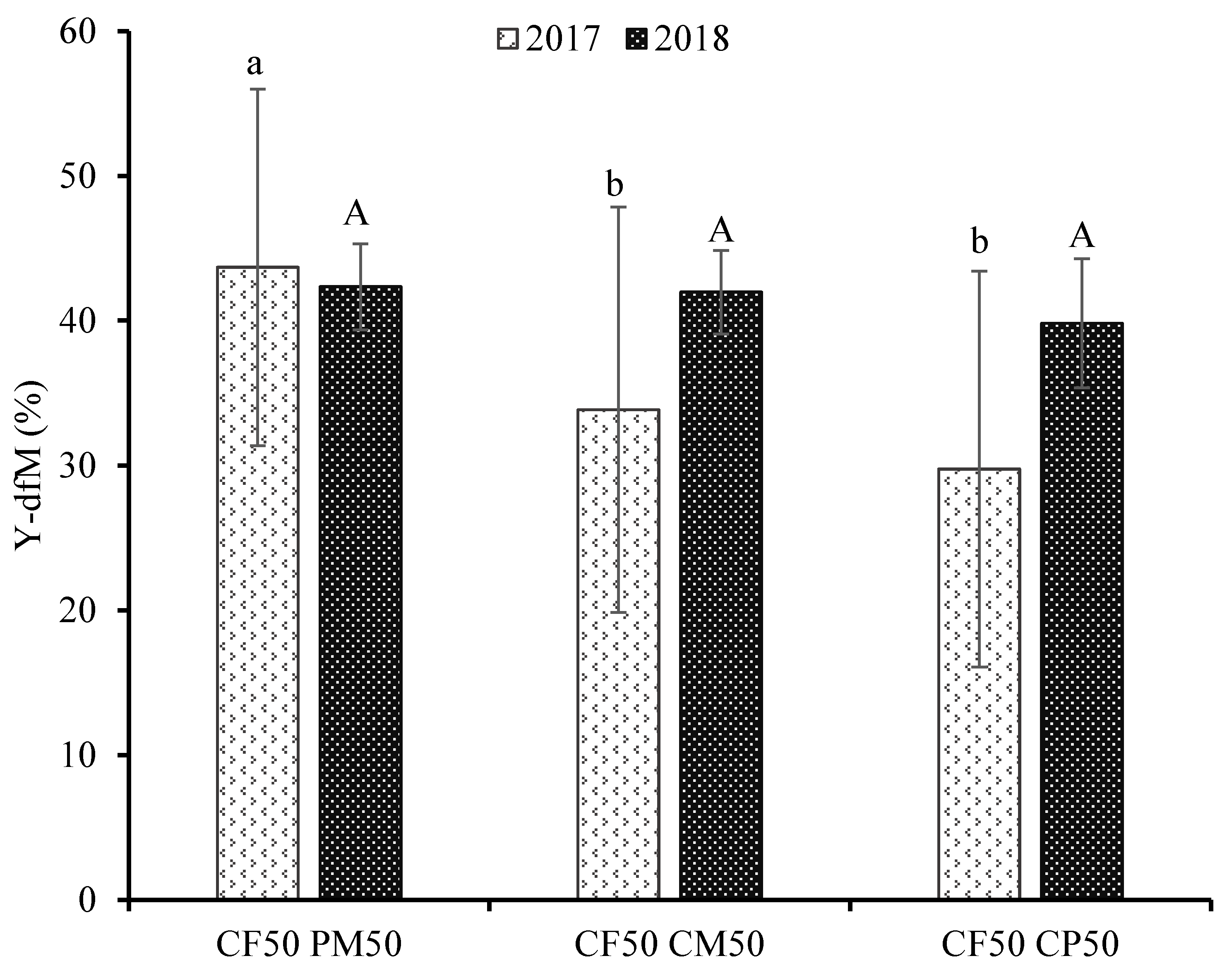
| No. | Treatments | Organic Fertilizers | Inorganic Fertilizers | ||||||
|---|---|---|---|---|---|---|---|---|---|
| DW | N | P2O5 | K2O | EMN | N | P2O5 | K2O | ||
| 1 | N0 | - | - | - | - | - | 0.0 | 60.0 | 85.0 |
| 2 | CF50 | - | - | - | - | - | 42.5 | 60.0 | 85.0 |
| 3 | CF100 | - | - | - | - | - | 85.0 | 60.0 | 85.0 |
| 4 | CF50 PM50 | 1745.3 | 85.0 | 79.5 | 37.3 | 42.5 | 42.5 | 60.0 | 85.0 |
| 5 | CF50 CM50 | 5927.4 | 141.6 | 113.2 | 90.1 | 42.5 | 42.5 | 60.0 | 85.0 |
| 6 | CF50 CP50 | 6558.6 | 141.6 | 148.8 | 93.1 | 42.5 | 42.5 | 60.0 | 85.0 |
| No. | Sample | C:N | Moisture (%) | Total % (Dry Basis) | |||||||
|---|---|---|---|---|---|---|---|---|---|---|---|
| N | NH4-N | NO3-N | P2O5 | K2O | Ca | Mg | Na | ||||
| 1. | Poultry manure | 6.80 | 21.86 | 4.87 | 0.75 | 0.00 | 4.56 | 2.14 | 8.85 | 0.75 | 0.28 |
| 2. | Cow manure | 15.23 | 46.40 | 2.39 | 0.19 | 0.00 | 1.91 | 1.52 | 1.09 | 0.55 | 0.34 |
| 3. | Compost | 17.71 | 41.02 | 2.16 | 0.04 | 0.02 | 2.27 | 1.18 | 5.28 | 0.21 | 0.85 |
| Treatment | Active Tillering | Panicle Initiation | Flowering | Harvest | ||||||
|---|---|---|---|---|---|---|---|---|---|---|
| Leaf | Sheath | Leaf | Sheath | Leaf | Sheath | Panicle | Leaf | Sheath | Seed | |
| 2017 N (%) | ||||||||||
| N0 | 2.84 b | 1.22 b | 1.55 c | 0.62 c | 0.84 b | 0.45 c | 1.08 c | 0.38 c | 0.52 b | 1.18 d |
| CF50 | 2.93 b | 1.07 b | 1.67 bc | 0.75 bc | 0.84 b | 0.50 bc | 1.11 c | 0.45 bc | 0.62 ab | 1.24 bc |
| CF100 | 3.27 b | 1.26 ab | 1.86 ab | 0.86 ab | 0.95 ab | 0.57 a | 1.24 a | 0.50 ab | 0.71 a | 1.31 a |
| CF50 PM50 | 3.87 a | 1.50 a | 1.95 a | 0.93 a | 1.05 a | 0.57 a | 1.20 ab | 0.56 a | 0.72 a | 1.27 ab |
| CF50 CM50 | 3.09 b | 1.07 b | 1.73 bc | 0.82 ab | 0.92 ab | 0.52 ab | 1.15 bc | 0.47 b | 0.63 ab | 1.22 bcd |
| CF50 CP50 | 2.87 b | 1.00 b | 1.61 c | 0.74 bc | 0.94 ab | 0.51 abc | 1.14 bc | 0.44 bc | 0.61 ab | 1.20 cd |
| 2018 N (%) | ||||||||||
| N0 | 2.93 a | 1.17 a | 1.70 c | 0.65 b | 1.02 b | 0.46 a | 1.18 a | 0.47 bc | 0.42 b | 1.22 c |
| CF50 | 2.79 b | 1.10 ab | 1.69 d | 0.66 b | 1.02 b | 0.45 ab | 1.10 a | 0.43 c | 0.45 b | 1.24 c |
| CF100 | 2.84 ab | 1.08 b | 1.79 ab | 0.67 ab | 1.04 ab | 0.44 b | 1.07 a | 0.53 ab | 0.59 a | 1.40 ab |
| CF50 PM50 | 2.93 a | 1.12 ab | 1.83 a | 0.74 a | 1.05 ab | 0.46 a | 1.08 a | 0.59 a | 0.59 a | 1.46 a |
| CF50 CM50 | 2.75 b | 1.07 b | 1.75 b | 0.66 b | 1.16 a | 0.47 a | 1.15 a | 0.50 bc | 0.48 ab | 1.28 bc |
| CF50 CP50 | 2.82 ab | 1.13 ab | 1.80 a | 0.68 ab | 1.09 a | 0.45 ab | 1.10 a | 0.53 ab | 0.52 ab | 1.41 ab |
| 2017 P (%) | ||||||||||
| N0 | 0.25 a | 0.25 bc | 0.20 a | 0.23 b | 0.08 b | 0.13 a | 0.20 b | 0.03 c | 0.03 c | 0.26 ab |
| CF50 | 0.24 ab | 0.24 c | 0.19 ab | 0.24 ab | 0.08 b | 0.13 a | 0.20 ab | 0.04 abc | 0.04 abc | 0.26 ab |
| CF100 | 0.25 ab | 0.26 ab | 0.19 ab | 0.25 ab | 0.08 ab | 0.13 a | 0.22 a | 0.05 ab | 0.05 ab | 0.26 ab |
| CF50 PM50 | 0.27 a | 0.27 a | 0.19 ab | 0.26 a | 0.09 a | 0.15 a | 0.22 ab | 0.05 a | 0.05 a | 0.27 a |
| CF50 CM50 | 0.24 b | 0.25 c | 0.18 b | 0.25 ab | 0.08 b | 0.13 a | 0.21 ab | 0.04 abc | 0.04 abc | 0.25 c |
| CF50 CP50 | 0.24 ab | 0.24 c | 0.19 ab | 0.24 ab | 0.08 b | 0.13 a | 0.21 ab | 0.04 bc | 0.04 bc | 0.25 bc |
| 2018 P (%) | ||||||||||
| N0 | 0.28 a | 0.28 a | 0.19 a | 0.25 a | 0.11 a | 0.19 a | 0.20 a | 0.05 b | 0.12 b | 0.27 ab |
| CF50 | 0.28 a | 0.28 a | 0.18 ab | 0.24 ab | 0.10 a | 0.18 ab | 0.19 a | 0.05 b | 0.12 ab | 0.26 b |
| CF100 | 0.26 a | 0.26 b | 0.19 a | 0.24 ab | 0.10 ab | 0.18 ab | 0.19 a | 0.05 ab | 0.14 ab | 0.27 ab |
| CF50 PM50 | 0.26 a | 0.27 ab | 0.19 ab | 0.25 a | 0.10 a | 0.20 a | 0.20 a | 0.06 a | 0.16 a | 0.28 a |
| CF50 CM50 | 0.27 a | 0.27 ab | 0.18 ab | 0.24 ab | 0.10 a | 0.20 a | 0.20 a | 0.05 b | 0.13 ab | 0.26 b |
| CF50 CP50 | 0.27 a | 0.27 ab | 0.17 b | 0.24 b | 0.09 b | 0.18 b | 0.19 a | 0.05 b | 0.12 ab | 0.28 a |
| 2017 K (%) | ||||||||||
| N0 | 2.69 c | 2.64 b | 1.81 c | 1.52 c | 0.71 b | 0.74 b | 0.48 b | 0.33 c | 0.87 b | 0.30 ab |
| CF50 | 2.77 ab | 2.61 b | 1.95 bc | 1.63 bc | 0.73 b | 0.87 a | 0.47 b | 0.41 bc | 0.84 bc | 0.29 b |
| CF100 | 2.73 b | 2.86 ab | 2.04 ab | 1.76 abc | 0.80 ab | 0.75 b | 0.56 a | 0.46 b | 0.82 c | 0.30 ab |
| CF50 PM50 | 2.96 a | 3.26 a | 2.19 a | 2.03 a | 0.92 a | 0.86 a | 0.51 a | 0.56 a | 0.95 a | 0.36 a |
| CF50 CM50 | 2.80 ab | 3.05 ab | 2.10 ab | 2.07 a | 0.87 ab | 0.85 a | 0.53 a | 0.43 bc | 0.91 a | 0.31 ab |
| CF50 CP50 | 2.86 a | 2.73 b | 2.07 ab | 1.89 ab | 0.85 ab | 0.86 a | 0.52 a | 0.40 bc | 0.91 a | 0.29 b |
| 2018 K (%) | ||||||||||
| N0 | 2.39 a | 2.63 a | 1.71 c | 1.66 ab | 0.92 ab | 0.99 ab | 0.58 a | 0.51 ab | 0.98 b | 0.36 a |
| CF50 | 2.35 a | 2.54 ab | 1.78 b | 1.65 ab | 0.91 b | 0.93 b | 0.49 b | 0.48 b | 1.02 ab | 0.32 a |
| CF100 | 2.23 a | 2.30 b | 1.78 b | 1.60 b | 0.89 c | 0.93 b | 0.50 ab | 0.47 b | 1.01 ab | 0.31 a |
| CF50 PM50 | 2.38 a | 2.52 ab | 1.85 a | 1.69 a | 0.93 a | 1.13 a | 0.50 ab | 0.61 a | 1.12 a | 0.32 a |
| CF50 CM50 | 2.36 a | 2.76 a | 1.86 a | 1.80 a | 0.98 a | 1.11 ab | 0.53 ab | 0.52 ab | 1.09 a | 0.31 a |
| CF50 CP50 | 2.36 a | 2.75 a | 1.82 a | 1.76 a | 0.96 a | 1.07 ab | 0.52 ab | 0.52 ab | 1.17 a | 0.34 a |
| Treatment | Accumulation (kg ha−1) | ||
|---|---|---|---|
| N | P | K | |
| 2017 | |||
| N0 | 65.6 d | 12.0 d | 50.9 d |
| CF50 | 83.4 cd | 15.9 c | 65.0 cd |
| CF100 | 125.1 ab | 20.9 ab | 81.9 b |
| CF50 PM50 | 132.7 a | 21.8 a | 99.4 a |
| CF50 CM50 | 100.8 bc | 17.5 bc | 74.1 bc |
| CF50 CP50 | 90.8 cd | 15.8 cd | 66.0 c |
| 2018 | |||
| N0 | 56.8 b | 12.9 c | 59.6 c |
| CF50 | 78.1 b | 16.9 b | 77.1 bc |
| CF100 | 123.4 a | 26.1 a | 92.0 ab |
| CF50 PM50 | 144.8 a | 28.7 a | 110.1 a |
| CF50 CM50 | 121.5 a | 25.3 a | 96.2 ab |
| CF50 CP50 | 129.9 a | 25.5 a | 102.3 ab |
| Treatment | Harvest Index | No. Panicle Hhill−1 | No. Spikelets Panicle−1 | Filled Grain (%) | 1000 Grain Weight (g) | Max. Panicle Length (cm) | Yield (t ha−1) |
|---|---|---|---|---|---|---|---|
| 2017 | |||||||
| N0 | 0.37 b | 13.7 b | 66.9 b | 67.5 d | 19.5 a | 15.7 b | 3.8 c |
| CF50 | 0.33 c | 14.7 ab | 65.6 b | 73.9 bc | 20.6 a | 24.2 a | 4.5 b |
| CF100 | 0.45 ab | 17.3 a | 102.8 a | 77.2 ab | 19.2 ab | 24.5 a | 6.3 ab |
| CF50 PM50 | 0.48 a | 17.7 a | 121.0 a | 78.6 a | 21.0 a | 25.0 a | 6.9 a |
| CF50 CM50 | 0.49 a | 14.8 ab | 118.3 a | 71.4 cd | 18.2 ab | 24.3 a | 5.9 ab |
| CF50 CP50 | 0.49 a | 14.2 b | 106.7 a | 72.5 c | 18.4 ab | 24.7 a | 5.5 ab |
| 2018 | |||||||
| N0 | 0.36 c | 13.3 c | 67.2 b | 74.2 b | 17.3 a | 21.5 b | 3.1 c |
| CF50 | 0.38 bc | 16.8 b | 58.6 b | 86.1 a | 18.7 a | 23.2 ab | 4.3 b |
| CF100 | 0.46 ab | 17.7 ab | 103.8 a | 88.7 a | 18.5 a | 23.8 ab | 6.7 ab |
| CF50 PM50 | 0.51 a | 20.5 a | 123.1 a | 91.4 a | 18.9 a | 24.3 a | 7.4 a |
| CF50 CM50 | 0.51 a | 17.2 b | 119.3 a | 87.6 a | 18.5 a | 23.4 ab | 7.4 a |
| CF50 CP50 | 0.49 a | 17.2 b | 107.2 a | 89.0 a | 18.5 a | 23.5 ab | 7.1 a |
© 2019 by the authors. Licensee MDPI, Basel, Switzerland. This article is an open access article distributed under the terms and conditions of the Creative Commons Attribution (CC BY) license (http://creativecommons.org/licenses/by/4.0/).
Share and Cite
Moe, K.; Htwe, A.Z.; Thu, T.T.P.; Kajihara, Y.; Yamakawa, T. Effects on NPK Status, Growth, Dry Matter and Yield of Rice (Oryza sativa) by Organic Fertilizers Applied in Field Condition. Agriculture 2019, 9, 109. https://doi.org/10.3390/agriculture9050109
Moe K, Htwe AZ, Thu TTP, Kajihara Y, Yamakawa T. Effects on NPK Status, Growth, Dry Matter and Yield of Rice (Oryza sativa) by Organic Fertilizers Applied in Field Condition. Agriculture. 2019; 9(5):109. https://doi.org/10.3390/agriculture9050109
Chicago/Turabian StyleMoe, Kyi, Aung Zaw Htwe, Thieu Thi Phong Thu, Yoshinori Kajihara, and Takeo Yamakawa. 2019. "Effects on NPK Status, Growth, Dry Matter and Yield of Rice (Oryza sativa) by Organic Fertilizers Applied in Field Condition" Agriculture 9, no. 5: 109. https://doi.org/10.3390/agriculture9050109
APA StyleMoe, K., Htwe, A. Z., Thu, T. T. P., Kajihara, Y., & Yamakawa, T. (2019). Effects on NPK Status, Growth, Dry Matter and Yield of Rice (Oryza sativa) by Organic Fertilizers Applied in Field Condition. Agriculture, 9(5), 109. https://doi.org/10.3390/agriculture9050109





